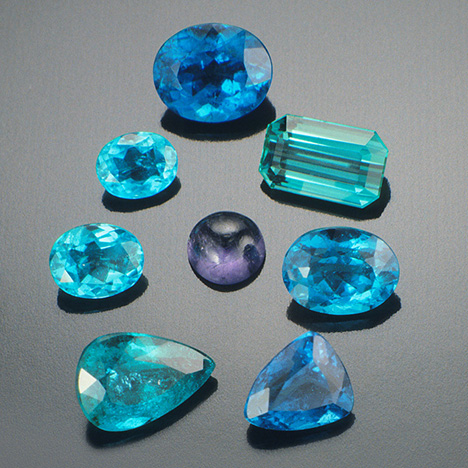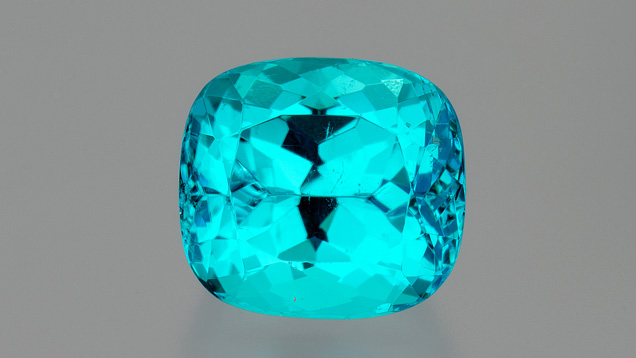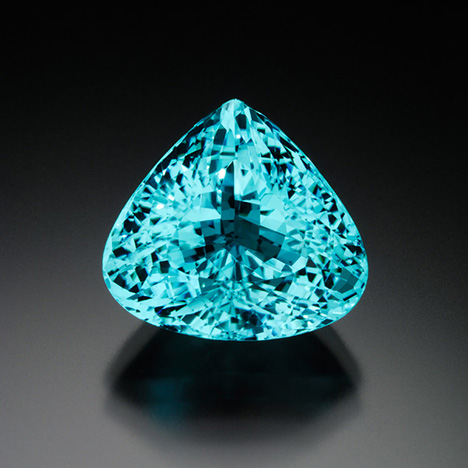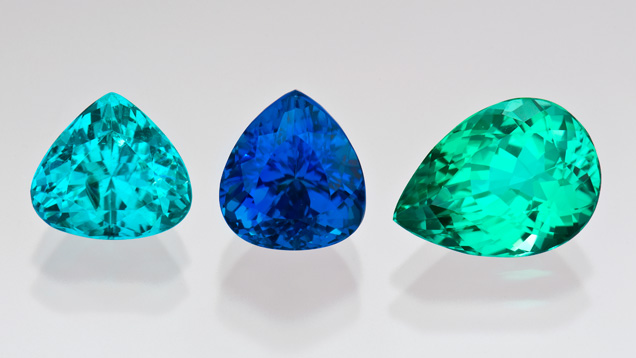Geographic Origin Determination of Paraíba Tourmaline

ABSTRACT
Vivid blue to green copper-bearing tourmalines, known as Paraíba tourmalines, are recovered from deposits in Brazil, Nigeria, and Mozambique. These tourmalines are sought after for their intense colors. Prices are based, in part, on the geographic origin of a stone, and determining provenance is thus an important aspect for Paraíba tourmaline. However, their geographic origin cannot be established by standard gemological testing and/or qualitative chemical analyses. GIA has established sophisticated criteria requiring quantitative chemical analyses to determine geographic origin for these tourmalines. These criteria were based on several hundred samples from known sources spanning the three countries. Highly accurate and precise quantitative elemental concentrations for Cu, Zn, Ga, Sr, Sn, and Pb are acquired with laser ablation–inductively coupled plasma–mass spectrometry (LA-ICP-MS). These data can then be plotted as a function of elemental concentration for accurate geographic origin determination.

INTRODUCTION
Copper-bearing gem tourmaline—recognizable by its vivid neon blue to green color—has been one of the most popular colored gemstones on the market for the nearly three decades since its debut (figures 1 and 2). It was first discovered in the state of Paraíba in northeastern Brazil in the late 1980s, and subsequently found in the neighboring state of Rio Grande do Norte (Fritsch et al., 1990; Shigley et al., 2001; Furuya, 2007). These gems became known as Paraíba tourmalines after the locality of their discovery. In the early twenty-first century, similarly colored gem-quality tourmalines were discovered in Nigeria and Mozambique (figures 3 and 4; Smith et al., 2001; Abduriyim and Kitawaki, 2005).


In the gem market, Brazilian Paraíba tourmalines are typically more highly valued than their African counterparts. While top-quality Brazilian Paraíba tourmalines tend to have more intense color, there is significant overlap in the color range for all localities. Additionally, standard gemological tests cannot definitively separate stones from these three localities. As a result, there is market demand for gemological laboratories to offer origin determination for copper-bearing tourmalines.
The most recent Laboratory Manual Harmonisation Committee (LMHC) definition of “Paraíba” tourmaline is “a blue (electric blue, neon blue, violet blue), bluish green to greenish blue, green (or yellowish green) tourmaline, of medium-light to high saturation and tone (relative to this variety of tourmaline), mainly due to the presence of copper (Cu) and manganese (Mn) of whatever geographical origin” (LMHC, 2012). This definition, widely accepted in the gem industry and at GIA, clearly mentions not only the color appearance but also the chemical elements causing the color. Iron (Fe) can also cause a blue coloration in tourmaline, such as the variety commonly termed indicolite (Faye et al., 1968; Mattson and Rossman, 1987). However, the bright blue color characteristic of Paraíba tourmaline is caused by Cu (Rossman et al., 1991) and easily surpasses the intensity and hue of indicolite’s Fe-related blues. Many years of trace element analyses at GIA have demonstrated that Cu occurs in many gem tourmalines in the range of single-digit parts per million by weight (ppmw) to tens of ppmw concentrations. However, such low levels of Cu will not produce the Paraíba-like color; at least several hundred ppmw Cu are required for that. Merkel and Breeding (2009) noted that peaks near 700 and 900 nm in visible and near-infrared absorption spectra can be useful in assessing the contribution of Cu when the stone also contains Fe. Mn, another element mentioned by the LMHC definition, can create purple and pinkish hues when in combination with Cu, thus impacting the color appearance of Paraíba tourmaline.
Because standard gemological properties and microscopic observations (e.g., mineral and fluid inclusions, fracture patterns, growth tubes) are not conclusive in distinguishing geographic origin for Paraíba tourmaline, other methods must be used. Quantitative chemical analyses of minor and trace elements have been collected and presented herein for Brazilian, Nigerian, and Mozambican material as used for locality determination (e.g., Shigley et al., 2001; Breeding et al., 2007; Laurs et al., 2008). Comparative studies of chemical data have also been carried out and discussed for the purpose of origin determination by several authors (Abduriyim et al., 2006; Peretti et al., 2009; Okrusch et al., 2016). For GIA’s lab service of Paraíba tourmaline origin determination, we have established an analytical and calculation protocol that utilizes major, minor, and trace element data obtained by LA-ICP-MS on reference samples from known localities.
PARAÍBA TOURMALINE GEOGRAPHIC LOCALITIES: A BRIEF SUMMARY
Most of Brazil’s Paraíba tourmaline mining sites are primary deposits in pegmatites that intruded quartzites or metaconglomerates between 530 and 480 million years ago (Ma) (Beurlen et al., 2011). Nigerian and Mozambican mines occur as secondary deposits where the tourmalines are recovered from alluvium rather than the original host rock (e.g., Laurs et al., 2008; Milisenda, 2018a). Paraíba tourmaline’s microscopic inclusions and gemological properties, however, are similar among the deposits on both continents, suggesting a very similar geological formation for copper-bearing tourmalines collected from primary and secondary deposits.
The regional geology of northeastern Brazil and western Nigeria primarily consists of igneous and metamorphic rocks related to the Brasiliano–Pan-African orogeny that occurred 650 to 480 Ma. In Mozambique, the tourmaline host rocks are pegmatites that intruded around 500 Ma, during or after the East African orogeny, which involved the agglomeration of landmasses and continental collision that formed the Gondwana supercontinent (Kröner and Stern, 2004; figure 5).

Brazilian copper-bearing tourmaline was formed by direct crystallization from a hydrous melt, rich in boron and lithium with an unusual concentration of copper, at the early stage of pegmatite formation in the quartz core and prior to the appearance of secondary lepidolite and other late hydrothermal minerals (e.g., Beurlen et al., 2011). The origin of the copper in Brazilian Paraíba tourmaline localities is still an open question, but some researchers have attributed it to copper enrichment of the host pegmatites or pegmatite-independent hydrothermal activity (Beurlen et al., 2011 and references therein). Laurs et al. (2008) discussed the alluvial paleoplacer deposit origin of Mozambican materials, and Pezzotta (2018) proposed a residual alluvial origin from field observations. The lack of copper-rich tourmaline in pegmatites located in the upstream area of Mozambique’s Paraíba tourmaline mines leaves the copper source unknown. Further field study is necessary to better understand the source of copper in Mozambican Paraíba tourmalines.
MATERIALS AND METHODS
GIA’s Paraíba tourmaline reference samples comprise a range of stones collected by researchers directly from the mines (Shigley et al., 2001; Laurs et al., 2008; Hsu, 2018); borrowed from personal and museum collections (some established before the discovery of the African mines, thus certifying that the stones are Brazilian); or obtained from highly trusted dealers specializing in tourmaline from particular sources (see the table 1 footnote for details). The GIA reference data comes from 151 samples from Brazil, 116 elbaite and 17 liddicoatite samples from Mozambique, and 17 samples from Nigeria.

For the past decade, GIA has chemically analyzed copper-bearing tourmaline samples by LA-ICP-MS. Two instruments have been used to collect this chemical data (with great care in calibrating the instruments to ensure that the data are internally consistent). A Thermo Fisher X-series II ICP-MS coupled with a New Wave Research UP-213 laser ablation unit was used initially, with National Institute of Standards and Technology (NIST) 610 and 612 references used for external calibration. Ablation was achieved using a 55 μm diameter laser spot size, a fluence of around 10 J/cm2, and a 15 Hz repetition rate. 11B was initially selected as an internal standard, although for comparison with data collected later the analyses were reprocessed with 29Si as the internal standard. Between 2014 and 2017, the LA-ICP-MS systems at GIA were upgraded to those currently in place, including a Thermo Fisher iCAP Qc ICP-MS coupled with an Elemental Scientific Lasers NWR213 laser ablation system. With this upgrade, data for most of the reference stones were recollected in order to ensure internal consistency of data collected on client stones using the new system. At the same time, data processing protocols were revised, with 29Si used as an internal standard and U.S. Geological Survey glasses GSD-1G, GSE-1G, and NIST 610 as external standards. Ablation is currently achieved using a 55 μm diameter laser spot size, a fluence of around 10 J/cm2, and a 20 Hz repetition rate. The isotopes routinely measured include 23Na, 24Mg, 27Al, 29Si, 39K, 43Ca, 51V, 53Cr, 55Mn, 57Fe, 63Cu, 66Zn, 69Ga, 88Sr, 118Sn, and 206Pb.
To date, results obtained from the two different standards sets, instruments, and operating conditions have not varied in the overall values of the trace elements used for discrimination. As a result, we have combined the data acquired from both old and new LA-ICP-MS systems for presentation. Both data sets for the elements selected in this study show a close overlap.
DISCRIMINATION DIAGRAMS FOR REFERENCE SAMPLES
Major Elements. Tourmaline is a supergroup mineral because of the large number of species under that classification. Overall, it is a complex boron-aluminum cyclosilicate mineral. The generalized formula can be written as XY3Z6(T6O18)(BO3)3V3W, with the primary occupancies of X = Na+, Ca2+, K+, vacancy; Y = Fe2+, Mg2+, Mn2+, Al3+, Li+, Fe3+, Cr3+, Ti4+; Z = Al3+, Fe3+, Mg2+, Cr3+; T = Si4+, Al3+, B3+; B = B3+; V = OH–, O2–; W = OH–, F–, O2– (Henry et al., 2011). The majority of gem-quality tourmaline is elbaite or fluor-elbaite, followed by solid solutions of dravite and uvite1. While most Paraíba tourmalines are elbaites, in 2010 copper-bearing liddicoatite1 appeared in the market (Karampelas and Klemm, 2010). Because calcium (Ca) is the dominant cation in the X-site for liddicoatites, they are easily distinguished based on major element analyses. Cu2+ in copper-bearing tourmaline is considered to be located in the Y-site (e.g., Ertl et al., 2013).
|
1elbaite = Na(Li1.5Al1.5)Al6Si6O18(BO3)3(OH)3OH fluor-elbaite = Na(Li1.5Al1.5)Al6Si6O18(BO3)3(OH)3F Note: While uvite and liddicoatite exist only as the fluor-dominant species listed above, the common names are used for simplicity. |
The normalization method established by Sun et al. (2019) allows for the accurate calculation of tourmaline stoichiometry from LA-ICP-MS analyses, with the exception of the fluor- and oxy-species. A ternary diagram of X-site composition of reference samples shows that there are two different primary groups for the Paraíba tourmalines: alkali and calcic groups (figure 6). Based on Y-site (Li-dominant) occupancy, the species are determined as elbaite and (fluor-)liddicoatite species.


Minor/Trace Elements. Among the minor and trace element concentrations measured, Cu, Zn, Ga, Sr, Sn, and Pb proved to be the most useful discriminators for Paraíba tourmaline geographic origin determination. The ranges, averages, and associated standard deviations of the concentration of these six elements for different localities are summarized in table 2. Brazilian samples have higher Cu (approximately 11400 ppmw on average, compared to less than 2000 ppmw for their African counterparts), but light-colored stones may have lower Cu concentration (figure 7A, B, and F). Nigerian samples have higher Sr (approximately 73 ppmw on average, compared to less than 4 ppmw elsewhere) and higher Pb (approximately 611 ppmw on average, compared to less than 50 ppmw for Brazilian and Mozambican elbaite samples); see figure 7B and C. Mozambican samples generally show higher Ga (both elbaite and liddicoatite are approximately 361 ppmw on average, compared to around 100 ppmw for other localities); see figure 7A, C, D, and E. High Zn (>1000 ppm) is limited to Brazilian samples, but Zn values below 1000 ppmw are not helpful discriminators (figure 7D and F). Most of the Nigerian samples contain high Sr and Pb (figure 7B and C). Any single pair of certain elements is insufficient to determine the geographic origin, but the combination of these elemental discriminators provides a robust tool for origin determination. In general, the results presented here are comparable to those in previous studies (e.g., Abduriyim et al., 2006; Peretti et al., 2009; Okrusch et al., 2016).

Using GIA’s reference data, four selected case studies for origin determination are shown in box A. Although most Paraíba tourmaline origin determinations are as straightforward as these case studies, some stones cannot be separated clearly, as some plot in overlapping locality fields and are not easily distinguished. When data plot in the middle of overlapping ranges for many element pairs, a definitive locality origin cannot be concluded. Such an example is shown as Case 4 in box A.

DISCUSSION
Geographic origin can be conclusively and accurately determined for the vast majority of Paraíba tourmalines based on their trace element profiles, allowing this service to be offered for Paraíba tourmaline in the gem and jewelry market, such as the fine-color Brazilian stones in figure 8. Nonetheless, there are some cases where an “inconclusive” call is warranted when the trace element profiles are ambiguous or contradictory. There are three reasons for the ambiguity:
- From time to time the laboratory examines Paraíba tourmalines that do not seem to match the trace element profiles of any stones in GIA’s reference collection. Obtaining reference samples with reliable provenance that match these unknown stones is currently a priority of GIA’s field gemology department; see Vertriest et al. (2019), pp. 490–511 of this issue.
- New chemical discriminators may be needed. Statistical approaches such as discriminant analysis or multivariate statistics may provide additional mechanisms to evaluate the certainty of the locality determination and reduce “inconclusive” calls.
- Chemical zoning in tourmaline may complicate interpretations. Color zoning is common in cuprian tourmaline and has been studied with electron probe microanalysis and LA-ICP-MS. In these studies, trace element concentrations correlate with color in naturally zoned samples (e.g., Laurs et al., 2008; Peretti et al., 2009). It is possible that the limits of chemical zoning of Paraíba tourmaline have not been included in the original fields for localities. Ideally, potential chemical zoning should be known before conducting LA-ICP-MS analysis so that all of the compositions can be captured. In tourmaline, however, chemical zoning may not include chromophores and may not be visually recognizable.
As noted earlier, liddicoatite can also be found in the Paraíba tourmaline market. Katsurada and Sun (2017) reported that the origin of the copper-bearing liddicoatite was unknown at the time of publication. Subsequently the source was identified as Maraca, Mozambique (Milisenda and Müller, 2017). For the purpose of Paraíba tourmaline origin determination, if the LA-ICP-MS analyses identify a cuprian tourmaline as liddicoatite, the stone’s origin is conclusively Mozambique.
Copper-bearing tourmalines are reported to occur in various colors, including pink, purple, violet, blue, and green (e.g., Laurs et al., 2008). Heat treatment is known to improve the color of cuprian tourmaline by changing the valence state of manganese ions from trivalent (Mn3+) to divalent (Mn2+), consequently reducing Mn3+ absorption in the visible range. This change can remove the purple and pink components of some stones, resulting in blue to green colors consistent with the Paraíba designation. Unfortunately, heat treatment is not always detectable. Appearance of a pink halo around tube-like inclusions, called “pink sleeves,” has been used as evidence of an unheated stone (Koivula et al., 2009). However, these features can remain in heated samples (S.F. McClure, pers. comm., 2017). Therefore, the colors of Paraíba tourmalines should always be considered to be potentially modified by heat treatment. One possible avenue of future research would be to study the trace element signatures of the various colors of Paraíba tourmaline, but of course this is complicated by the prevalence of heat treatment in most stones.
Different approaches have been proposed for determination of origin. These techniques include, in part, using isotopic compositions of boron and lithium (Shabaga et al., 2010; Ludwig et al., 2011), photoluminescence spectra (Milisenda, 2018b), and laser-induced breakdown spectroscopy (LIBS) with multivariate statistics (Dutrow et al., 2019). These approaches may be helpful as additional techniques to enhance chemical fingerprinting and facilitate origin determination.
CONCLUSIONS
Based on GIA’s database containing more than 300 Paraíba tourmaline samples with known provenance, geographic origin determinations can be made using a variety of minor/trace element data when collected by highly precise and accurate methods. In the modern gemological laboratory, the weight of the origin determination rests overwhelmingly on trace element analysis by LA-ICP-MS. Paraíba tourmalines from Brazil, Mozambique, and Nigeria can, in most cases, be identified by their unique fingerprints of concentrations of trace elements such as Sr, Cu, Zn, Ga, Sn, and Pb. Additionally, the more recent find of Paraíba tourmaline belonging to the liddicoatite species can be identified through major element analysis. However, in a few cases “inconclusive” origin determinations may result when their trace element profiles do not match with any reference samples of known provenance. By improving the database with additional reference samples and conducting further research on analytical methods and statistical analyses, fewer Paraíba tourmalines will require an “inconclusive” call.






